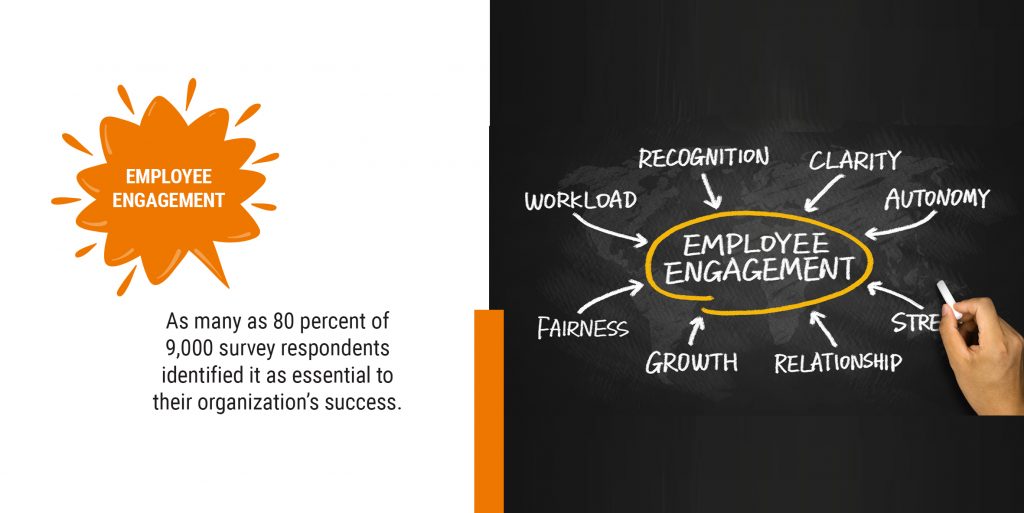What is tuning off employees today? Is it less money? Is it the furniture? Is it the quality of coffee in the canteen? Is it the sketchy quality of the video-conference meeting? It can be anything. It can be an answer that lies in plain sight, but sometimes we still fail to see it. Engaging employees is one of the most effective business strategies, but it’s easier said than done. And today’s HR leaders need innovative employee engagement strategies that actually work.
Engaged employees, a more than a nice-to-have factor
Staying connected to employees, listening to their concerns, and harnessing their energy will be critical to making progress on the business transformation journey. And of the top barriers that can get in the way here, employee exhaustion, burn-out, and lack of employee empowerment arrest a lot of attention. Not too far, in the 2020 Deloitte Global Human Capital Trends study, well-being was the top-ranked trend for importance.

Employee engagement is not a luxury to be indulged when HR has the time or funds to do it. It is a vital factor. Without proper attention and interventions, all the hard work, time, and energy devoted to recruitment and training can fall apart. Visionary HR leaders keep employee engagement strategies at the top of their priority list, not buried in the footnotes. When your employees feel inclined, involved, and fulfilled at work, they tell you that you are good at building great employee engagement strategies.
A continuum of Gallup research reaffirms that engaged employees produce better business outcomes than other employees – and this is applicable across the industry, company size, nationality, and in good economic times and bad.

Employee engagement strategies that actually work
No wonder, sound and smart employee engagement strategies take care of all minor and significant expectations that an employee may have from their organization. Some of these are imperatives, and some can differ in degree from region to region, from organization to organization:
- Appreciation and motivation
- Fair compensation
- Fair treatment in assessments and appraisals
- A positive work climate
- A happy work culture
- Resilience to pandemic-led disruptions
- Flexibility and work-life balance
- Diversity and inclusion
HR leaders have started embracing new employee engagement strategies and tactics to enhance what they do. They are using technology in many aspects to ensure that their employees are happy, fulfilled, and well-equipped in the organization.
- Enhanced and seamless collaboration
- Augmentation of employees through technology in the right places
- Transparent and fair skill assessment
- Well-executed reskilling and up-skilling avenues
- A cohesive and positive environment for interactions
- Democratic work culture
- Flexibility and agility
- Proactive measures for fighting disillusionment, fatigue, and stress
- Transparency, accountability, and equity
- Environmentally-responsible and SDG-friendly practices
- Mental health upliftment and counseling
- Timely and fair, recognition and empowerment
- Feedback-friendly culture and ample scope for conversations
- Balance of career, competence, and care in core HR areas
- Succession planning and leadership development opportunities
- Work-life balance and encouragement of purpose beyond work
- Relationships, purpose, and meaning in work
Employee engagement starts with your recruiting process
As per the 2021 Deloitte Global Human Capital Trends Survey, it is also essential to instill changes in work design to make remote work sustainable. The top factors here were:

A lot of this impact on employee engagement starts with your recruiting process. This is where visionary HR leaders, recruiters and talent acquisition heads are already miles ahead. They are using innovative recruitment platforms for AI-driven recruiting, coding assessments, and video interviewing. Like Oto_Code, Oto_Qualify, and Oto_Live.
It’s time to reflect deeply on what keeps your employees engaged sustainably and positively. Of course, you cannot keep them on cloud nine all the time. But you cannot afford to keep them boxed up in outdated HR approaches too. Not when technology can be your biggest and easiest ally.
- Embracing Agility and Inclusion: The Power of a Skills-First Approach in Talent Management - August 14, 2023
- How to Reduce Time to Proficiency and Measure Onboarding Effectiveness - August 10, 2023
- Unleashing the Power of AI: Transforming Learning and Development in Your Organization - August 1, 2023

